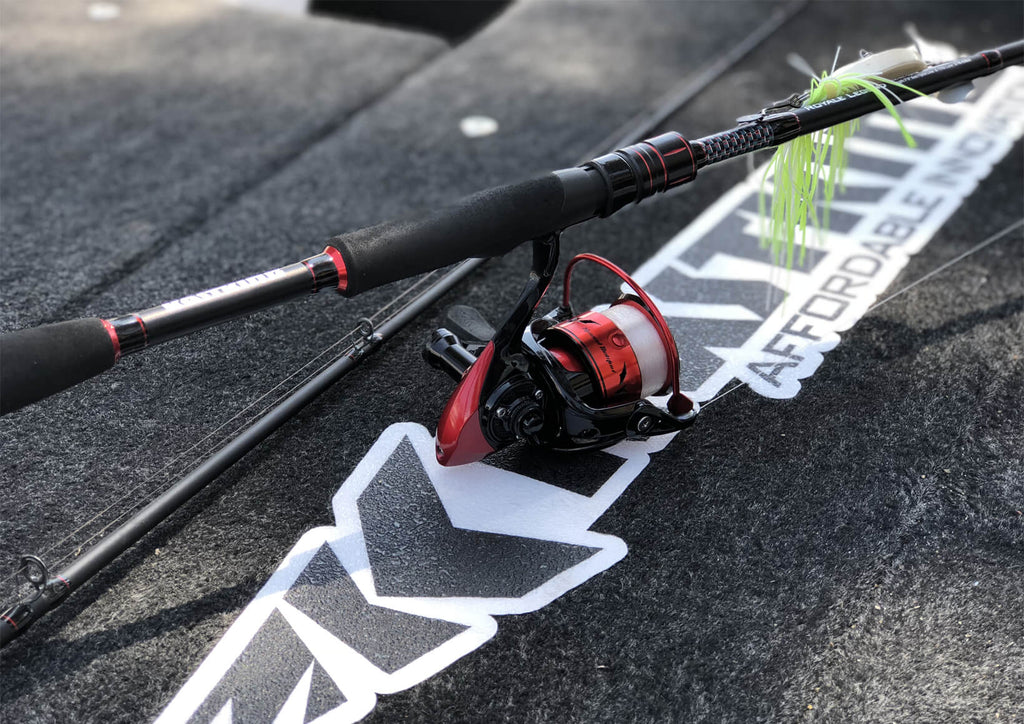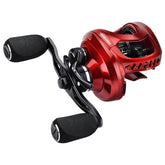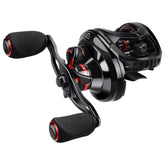
Fishing Tackle - The Balance of Power
Matching the best fishing reel to the best fishing rod for balance and the best setup as a rod and reel combo.
I’ve seen this problem exist among newbie and veteran anglers alike …the matching up of the correct size and types of fishing tackle.
A fishing reel, fishing rod and fishing line need to work as a coordinated unit, with one part not overshadowing the others by being too heavy or too light. There needs to be balance within the components themselves and balance in the relationship of the components.
Fishing tackle also needs to be matched to the size and species being fished for. There’s an old expression, “Fish don't break fishing tackle, fishermen break tackle.” A lot of breakage can be avoided through proper fishing gear selection.
THE FISHING ROD

Select your fishing rod for the line size (lbs. test) and lure size (ounces) for the size and species of fish targeted. Go back and read that sentence again. The relationship, the balance, has to be shared among all of the components. Using too heavy of a fishing line, whether you are fishing with monofilament line, fluorocarbon line, or braided fishing line, could lead to snapped off rod guides or at the least, it will cut down on casting distance. Too light of a line on too heavy of a rod will lead to snapped lines. Using a heavier line beyond a given point, is not necessary if the drag on your reel (more about that later) is set properly. Many falsely believe that a heavier line will prevent bite offs, and break- offs by a big fish. If you are going after toothy game fish, or fishing a rocky area, use a heavy monofilament or fluorocarbon leader connected to a proper main line size that is matched to the rod, reel, and drag. Or, use a wire leader for bigger, more vicious fish.
Some anglers are dazzled by high drag settings available on some (usually more expensive) fishing reels. Here’s the problem. The drag setting, the amount of force in pounds of pulling force, should be no more than one third of the fishing line’s test strength. If you are spooled up with 30 pound test line, big enough to handle very large fish, the drag would be set at ten pounds of pulling force before the drag slips. Okay – knowing this, why would you want a reel that can develop 55 pounds of drag? In theory, that’s enough drag for 165 lbs. test line (55 is one third of 165). That’s enough force for massive deep water game fish. And, enough force to rip the guides out of a rod not built to handle it. So, if you have a rod rated for 14-30 pound line, would you consider such a large drag capacity necessary?
Another misnomer is that some fishermen think ten-pound test line is necessary to handle fish weighing up to ten pounds (or 30 pound line for a 30 pound fish, etc.). That’s far from true. Let’s take some of the aforementioned info and apply it here.
Scenario: you’ve spooled your fishing reel up with ten-pound test line, tied 30 inches of 30 pound test fluorocarbon line on as a leader because you are concerned about your thinner main line chaffing on rocks, carefully tied knots, (knots reduce line strength) and using a pull type fishing scale, properly set your reel’s drag to three pounds of drag before slipping occurs.
Your reel is well-maintained; the drag washers were recently serviced and capable of generating fourteen pounds of maximum drag. It’s mounted on a quality seven-foot spinning rod. Medium-Heavy power, 10-20 Lbs. line, 1/2 – 1 1/4 ounce lures, the manufacturer has listed on the side of the rod. You’re casting one-ounce lures. Perfect.
You head out to fish. You hook what you almost find out later to be a fifteen-pound fish. How’s that possible? The line test strength is only ten pounds, the drag is set at three pounds, and okay, there’s a 30 pound leader… but that’s not the weak link.
The fish, after being hooked, starts to pull out line and your drag sings like crazy. Dzzzz, zzz, zzzz! The fish beings to tire a little – remember he’s swimming and dragging around the equivalent of three pounds of weight – about 20 percent of its body weight. With each surge the drag resists against the pull. The drag is doing its job. The slippage is preventing the line from breaking (because that would take ten pounds of force to happen). After a good battle of you cranking in between the drag doing its job of slipping, you get the fish to the shore. You are delighted. Nice fish! you say to yourself. Bigger than you were hoping for, but within the limits of your gear. Holding your rod with your right hand, you reach out and grasp the line with your left. Snap. The fish lands back in the water and swims off.
What happened? In your excitement you grabbed the ten pound test main line; not the much heavier leader line. The fish weighing fifteen pounds, and no longer buoyed by the water, and with the reel’s drag no longer in play to allow slippage since you grabbed the line between the dead weight of the fish and the reel, exceeded the breaking strength of the line. Large fish are taken on fishing line with breaking limits far below the fish’s weight all the time when the proper fishing practices are used.
The size of the lure weight listed on the rod manufacture has a lot to do with castability. A medium power rod rated for lures between ¼ and ½ ounce will not fare well trying to launch 1/8 ounce fishing lures. Too heavy of a lure will likely snap the line. You not only lose your lure, but face potential danger as the hooks go hurtling through the air at you or an innocent bystander.
A balanced fishing rod and reel combo keeps your hands relaxed allowing you more sensitivity to detect tiny changes in line tension (bites and nibbles). A balanced setup reduces fatigue in your hand, wrist and forearm since your muscles won’t have to make micro-adjustments while casting.
Let’s look at fishing rod balance. Whether you’re using a baitcaster or spinning rod, it’s easy to check its balance. With your reel loaded on the rod and spooled with line, on a bait caster put your index finger under the rod just in front of the reel. This will create a balance point for the rod to rest on. If it’s well balanced, there will be equal weight distribution on either side of your finger. If the tip tilts down, the rod is too heavy for the reel. If the handle tips downward, select a lighter weight reel for optimum balance.
For a spinning rod, place your finger at the point where the reel is seated on the rod. The same rules of balance apply to the spinning rod.

Think about what technique you'll be using most often before you get too concerned about rod balance. A balanced rod and reel combo comes into play more with still-presentation lures (baits typically fished with the rod tip at the 10 o'clock position)– worms, jigs, and the like, or fishing lightweight lures with the rod tip elevated, need correct balance. It’s less of an issue with lures that are fished fast or retrieved with special action.
The key is to find a fishing combo that doesn't quickly tip in one direction or the other when you're balancing it on your finger…or fishing. Some rod and reel combos may be slightly out of balance. Depending on your techniques, it may not matter as much. Moving-bait presentations don't need to be (as) balanced because they are fished holding the tip down.
Many tackle set-ups do not have perfect balance. If you already have a rod and reel and they’re out of balance, all is not lost. If you are tip end heavy, you can put a weighted cap on the rod handle’s butt end. Ask your local hardware store about crutch butt caps (a rubber stopper- like non-slip piece that goes on the end of a walking cane). They may have one in the size you need. That may be all it takes. If a little more weight is needed, place some washers under the cap to micro-tune the balance. Don’t epoxy the cap on; use something like silicone glue so you can change the cap if you change reels. There are manufactures that sell butt-cap kits. If the rod is too tail heavy, you may want to opt for a lighter fishing reel.
Although a perfectly balanced fishing rod improves sensitivity and reduces arm fatigue during long casting sessions, you can cast heavier baits farther with a bottom-end heavy rod. You could consider having two set-ups for different conditions. One balanced to reduce fatigue and increase rod sensitivity, the other for heavier, fast-moving baits.
THE FISHING REEL

As pointed out, enough available drag power, along with appropriate fishing line capacity, is the starting point for selecting a reel. Keep in mind, excessive line capacity adds weight to the reel since a bigger spool is needed to handle the longer line, and is not necessary. Most fish will not run that far. That, combined with how far you can cast, will determine how much line you will need. Offshore or bottom fishing requires more line. For inshore saltwater fishing and most pond and lake situations 100 to 150 yards is often more than enough. Big game and surf casting calls for more capacity.
Fishing reels are rated in sizes from 500 (ultra-light), and up. 1000, 2000, 3000 and all the way up to massive heavy service 10,000 size reels. These numbers are good for comparing reels between manufacturers. Although features such as the number of bearings and the weight of the reel based on the materials it is made from (for example graphite is lighter than metal, but thinner walls can be cast for metal reels) may vary between makers in the same class size – the size and capacity will be similar. In other words, a 2000 size reel from manufacturer A will be close in size to manufacturer B, but may have other, different features that do not affect its size.
It goes back to balance. A 1,000 size reel on an eleven-foot surf rod is just as out of balance as a 8,000 size fishing reel on a seven foot, medium-light power rod. These are extremes and exaggerations, but you get the picture. An 8,000 series reel on an eleven-foot surf casting rod may be perfectly fine and the 1,000 size fishing reel may balance the seven-footer perfectly.
THE FISHING LINE


The thicker the diameter, the less distance you will be able to cast. Braided line offers an advantage here. Ten-pound braided line has the approximate thickness of three-pound monofilament, yet retains the ten-pound breaking strength. It also allows you to wind more line on the spool.
Heavier lines are for bigger fish and bigger fish means bigger baits. Again – the right size tool for the job. A heavy weight 40 pound test monofilament line is not going to allow you to cast light weight lures effectively, and may result in a nonstop series of bird’s nests and tangles. Heavy fishing line needs a heavier projectile to pull it off the reel and overcome wind resistance. It’s a matching game of the size of the fish you are targeting, to the size of the bait, to the size of the line to cast and work the bait properly, (presentation) and the rod and reel needed to handle it.
You may wish to opt-up slightly in line strength for insurance. Don’t overdo it. Keep everything relative. With heavier lines a two to five pound difference may be negligible while lighter lines may only allow you a one to two test pound difference. Keep in mind thinner line and heavier lures cast farther. Again, see what the rod maker has listed on the side of your rod for the correct size line. There’s a reason for these limits. If you vary from them, do so at your own peril.
There are exceptions to every rule. Some angler using frog baits in heavy cover – lily pads, grass and the like, will use a very heavy braided line (50 – 65 lb.) solely for the purpose of cutting through the vegetation and horsing a fish out. Again, an exception to another rule is tightening the drag down in excess of the recommended 30% of line strength to pull a fish through the cover. Since frog lures typically weigh less than a half ounce and the targeted fish’s weights are not likely to exceed the load capacity of the line or rod; there is not typically a danger of snapping either with this technique.
Fishing should be about having fun and relaxing. Keeping your fishing tackle in balance will go a long way in starting, and ending, every fishing trip the right way. Selecting the right fishing gear the first time will save you money.
– Excerpt from author Tom Gahan’s upcoming book, Tales of the Frugal Fisherman












